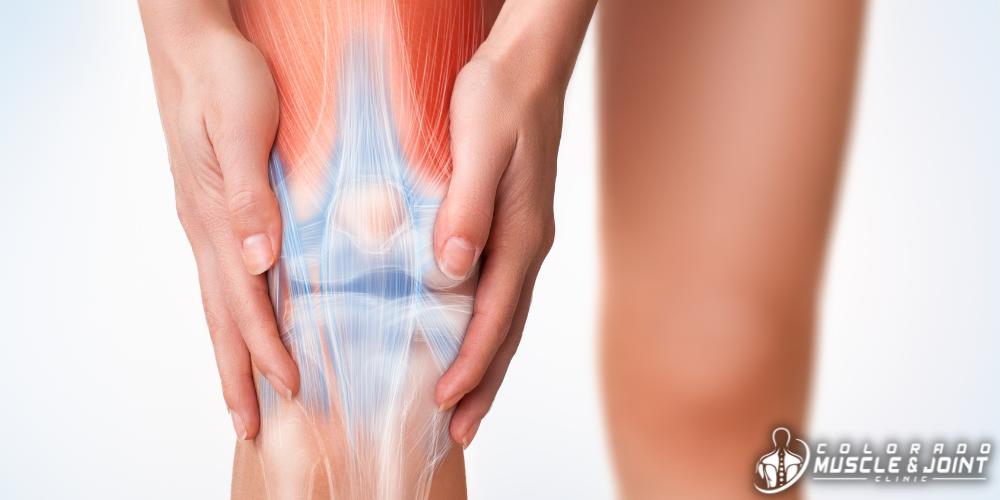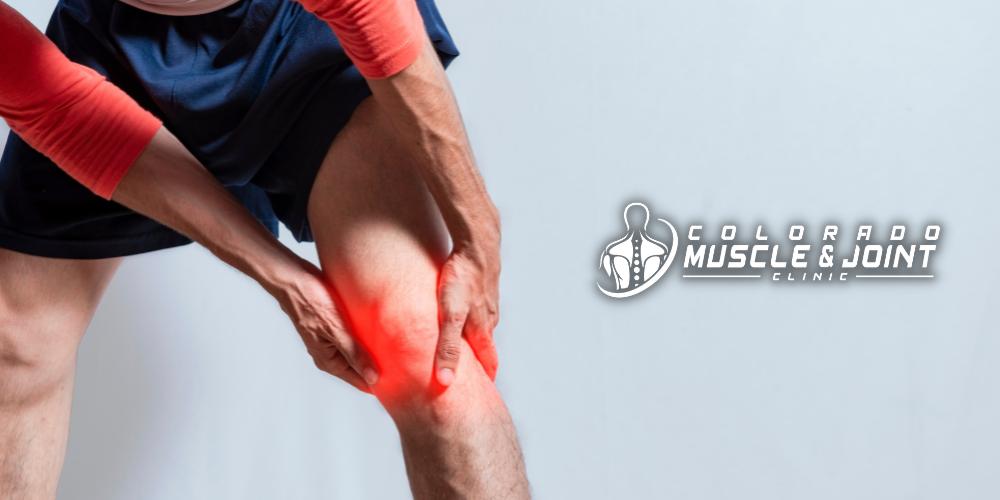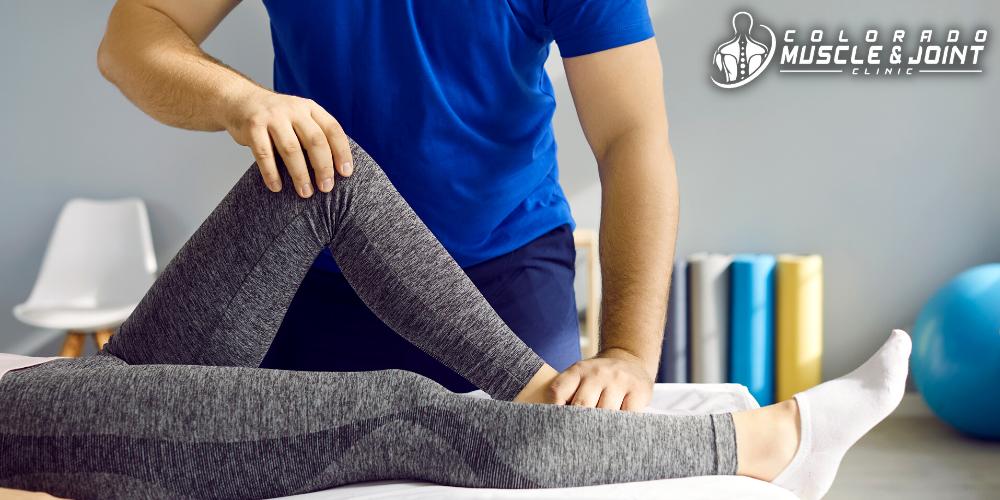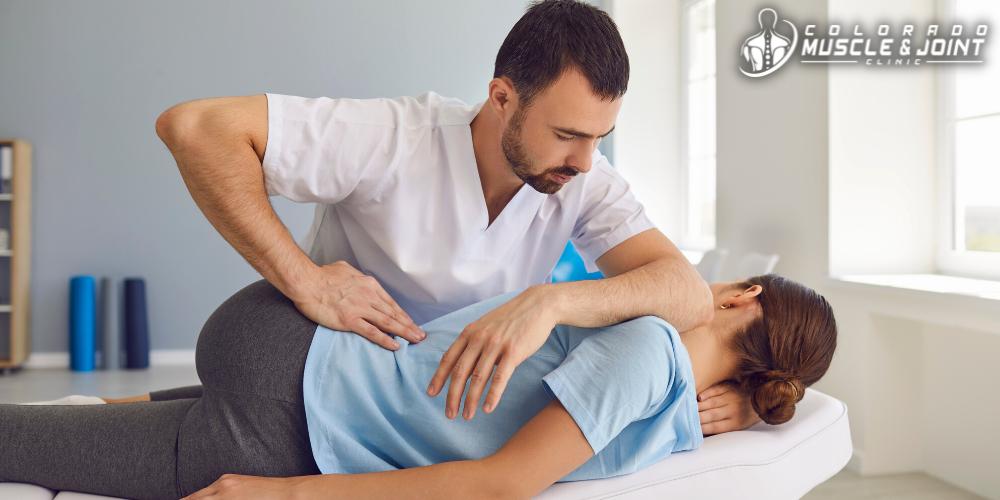Leg Pain
Chiropractic Care for Leg Pain
There are numerous types of leg pain that we can suffer from throughout our lives. Most of the time, the underlying cause is nothing more than a muscle cramp or a strained muscle from accidents or overuse. More rarely, leg pain can indicate a serious underlying medical condition that needs immediate treatment. Below, we list some of the most common causes of leg pain, and whether or not chiropractic treatment can provide you with relief.

If you’re enduring pain anywhere in your musculoskeletal system, Dr. Huebner at the Colorado Muscle & Joint Clinic may be able to give you relief through a variety of manual therapy treatments. He offers spinal manipulation, myofascial release, neuromuscular rehabilitation, Kinesio taping, and so much more. Call 970-744-6499 to schedule an appointment today.
What Leg Pain Can Feel Like
The location and exact type of leg pain you’re experiencing can indicate a wide variety of health conditions. For example, people can feel pain in their entire leg, in just their lower leg, or in just their upper leg. People can also experience leg pain along with knee or ankle pain.
Leg pain can feel like shooting pain, radiating pain, dull aching, throbbing, tingling, or numbness. Other symptoms that can accompany leg pain include muscle weakness, swelling, bruising, muscle cramping, or a physical deformity.
What is the Most Common Cause of Leg Pain?
The most common cause of leg pain is degradation and/or overuse of the leg joints and muscles. Both of these issues can be the result of the natural aging process, but it can also be the result of too much exercise or frequent repetitive motions.
Common Causes of Leg Pain
There are countless health conditions that could be causing leg pain. Below, we discuss some of the most common causes of pain in the leg(s) to help you determine if a trip to the doctor is necessary.
Muscle Cramps
The most well-known leg cramp is the charley horse, which usually occurs in the calves. Involuntary leg cramps can cause severe pain, but the good news is it’s usually short lived. A muscle cramp in the legs is usually the result of dehydration, muscle fatigue, too much exercise (especially in the heat), poor circulation, or a magnesium or potassium deficiency. If you massage cramping muscles, you may experience some relief.
Sprains and Strains
A sprain or a strain is a torn or overstretched muscle. Muscle strains and sprains can be caused by a sports injury, a slip and fall accident, or simply overstretching. The largest leg muscles are the most likely to become strained or sprained, such as the quadriceps, hamstrings, and calves.
A muscle strain or sprain in the leg can feel sharp, dull, or throbbing. The injured leg may also appear bruised and swollen. Although muscle strains are incredibly painful, they are not life-threatening. With some rest and ice or heat therapy, you can be back on your feet in no time.
Sciatica
The sciatic nerve is the longest and thickest nerve in the human body, with the thickness being about the width of a finger. It branches off of the bottom of the spinal cord and travels down the butt and both legs, ending below the knee. The sciatic nerve provides both motor and sensory function to the lower half of the body.
Sciatic nerve pain occurs when the nerve becomes compressed somehow, usually due to a herniated disc, piriformis syndrome, or even spinal stenosis. Compressed spinal nerves can cause pain throughout the body, depending on the location of the compressed nerve. Because the sciatic nerve is located at the bottom of the spinal cord, compression will cause pain in the lower half of the body, usually in the butt and one leg.
The pain from compressed spinal nerve roots can feel burning, tingling, shooting, and radiating. Many people experience butt or leg numbness from sciatica as well.
Shin Splints
Shin splints occur when the soft tissues surrounding the shin bone – such as the tendons and muscles – become inflamed and painful, usually due to intense exercise. Runners are commonly afflicted with shin splints, but people with flat feet or poor footwear can suffer from this type of pain as well.
The best way to heal shin splints is through rest, ice or heat therapy, and pain relievers.

Bone Fractures
The legs are made up of three main bones: the femur, the tibia, and the fibula, all of which can suffer stress fractures during intense exercises or accidents. A stress fracture in the leg can cause severe pain and sometimes swelling as well. More severe leg fractures can result in visible deformities.
Hip and ankle fractures can also cause severe pain in the leg.
Tendinitis
Tendons are responsible for connecting muscles to bones. Tendonitis occurs when tendons become inflamed, again due to intense exercise or accidents. An inflamed tendon can cause sharp or dull pain in the leg, swelling, and poor mobility. Leg tendonitis most commonly affects the hamstrings and the calves, near the heel bone.
Arthritis
There are several different types of arthritis that can cause pain in the legs. Gout is a common form of inflammatory arthritis in which uric acid builds up and crystallizes in the joints. It commonly affects the big toe, but it could also affect the knees and hips.
Other types of arthritis that could cause pain in the legs include rheumatoid arthritis, which is an autoimmune disease, and osteoarthritis, which is a degenerative joint disease. All forms of arthritis can cause pain, swelling, redness, and poor mobility in the legs.
Circulation Issues
Lastly, poor blood flow in the legs can cause intense pain as well.
Deep vein thrombosis occurs when a blood clot forms in a deep vein in the leg due to certain medications or long-term bedrest. This condition can lead to pain, swelling, and throbbing in one or both legs. Deep vein thrombosis can turn into a serious condition called a pulmonary embolism if the blood clot becomes loose, travels up to the lungs, and blocks blood flow.
Varicose veins are enlarged veins that appear in the top layer of skin, most commonly in the lower legs. Unlike deep vein thrombosis, varicose veins are usually nothing more than a cosmetic concern. But some people can experience throbbing pain and discomfort from these enlarged veins.
Atherosclerotic peripheral arterial disease is a circulatory condition in which the arteries that carry blood from the heart to the legs become narrowed or clogged. Decreased blood flow to the legs caused by peripheral artery disease can naturally result in pain, especially in the calves.

Can Chiropractic Care Help Leg Pain?
Yes, chiropractic care can relieve chronic pain in the legs that’s caused by a variety of musculoskeletal pain syndromes. Chiropractic care is considered secondary and alternative care, so it’s important to seek a diagnosis and medical treatment from a medical doctor first.
Chiropractic treatment may provide leg pain relief caused by:
- Sprains and strains
- Frequent muscle cramps
- Sciatica
- Tendonitis
- Previous injuries, such as bone fractures and shin splints
The goal of alternative care like physical therapy, massage, or chiropractic is to support the body’s natural healing process so that you can live a happy, active life, without relying on daily pain relievers.
Chiropractic Treatments for Leg Pain
Before Dr. Huebner moves forward with chiropractic treatment, he will ask you about your leg pain and other symptoms. He will also perform a brief physical exam to determine the source of the pain. Then he’ll recommend one of the chiropractic treatments below, which can not only relieve leg pain, but improve overall mobility and flexibility as well.
- Spinal Manipulation can possibly improve sciatica pain that’s caused by herniated discs or spinal misalignments. During a spinal adjustment, Dr. Huebner will use his hands to apply a quick, controlled thrust to a misaligned portion of the lower spine. Regular spinal adjustments may reduce pain and inflammation of the spinal nerves, which could reduce or completely relieve sciatic nerve pain.
- Myofascial Release is a type of massage that focuses on relieving pain and tension from trigger points in the body. If your leg pain is caused by tight muscles, past injuries, or frequent muscle cramping, this treatment may provide relief.
- Neuromuscular Rehabilitation may provide relief from leg pain caused by muscular injuries and nerve damage. This type of treatment involves specific exercises that help patients restore normal communication between the nerves and the leg muscles so that they can regain full mobility.
- Kinesio Taping can help people recover from sports injuries involving the soft tissues in the hips, legs, and ankles. Kinesio tape is a type of therapeutic tape that’s strategically applied to parts of the body that need extra support while healing from injuries. It may provide relief from pain and swelling as well as restore normal mobility.


